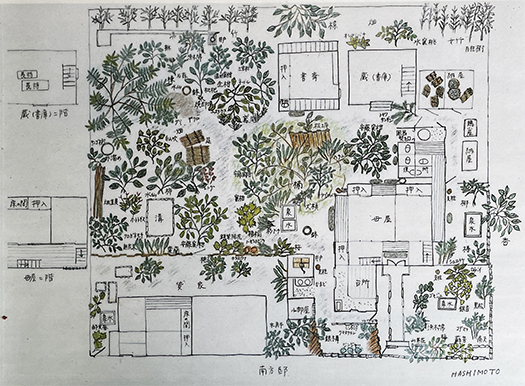
今回関西方面に来たかった目的のひとつが、こちらの南方熊楠氏の記念館や自邸などの探訪。大阪府内の根拠地としている地・堺市からいつも使っているレンタカーで一路、南紀白浜に向けて移動。
わたしは仕事生活は一段落したわけですが、相変わらず「住宅探訪」は習い性になっていて、いまは全国に残っている人物とその住環境、みたいなテーマで行脚を続けているのです。住宅雑誌を創刊して、現実に建っている住宅について、主にその「作り手」主体の取材をしてきたのですが、どうしてもそうすると「個人情報」の制約が強くなってきて、住まいの基本要素である「人間の本然の実現」みたいな部分に十分には突っ込んでいけない部分を感じてきていた。
もちろん多くのユーザーにとっては「家を建てる、持つ」というモチベーションが人生のひとつの究極的願望であるので、その目線から「作り手選び」という市場性が有り、それはまた作り手の「表現」でもあるので、そういうメディアは強い存在価値があり続けると思っています。
わたしの場合には、そのNEXTとしてより人間性に深く絡むような部分を「深掘り」してみたい、という願望なワケですね。そうすると「個人情報」の制約からかなり自由な、昔人・有名人とかの個性の刷り込まれた住宅というのが、素材を提供してくれる。そして住情報に接してきての一定の知見から、それらをすこし違った視点から見ることができるように思われるのです。興味が非常に深くなるというか。
今回は日本史の中でも非常に特異な「知の巨人」と言われ続けている「南方熊楠」に興味が盛り上がってきた次第。こういった個人的取材の流れの中で日本民俗学の祖とされる柳田國男についてはすっかり深入りして、ほぼその「空間世界」体験を得たのですが、柳田とも深い交流を持って南紀に住まい続けたかれのことを取材したいと強く思った次第です。
写真は田辺市内に残っている自邸。隣接して「顕彰館」もあります。

そしてこちらが公開されていた自邸の間取り。塀から顔を出している「本屋」には2階が一部にあるようですが、全体としては平屋で「分棟」形式を取っている。用途目的別に小建築が有機的に絡み合って相互連携しているカタチ。今日のような敷地面積の極小化が進展する以前の、いわば日本的な住伝統のひとつのカタチだと思います。古民家などでもこういった形式はよく見られる。
そして植物学に深い知を集中させていったかれらしく、植生についても住空間と「呼応」させていると感じられる分布ぶり。ヤブ蚊に悩まされつつ、いっとき南方さんの暮らしぶり、生き方との「対話」体験を過ごさせていただきました。感謝。
English version⬇
Exploring “Kumagusu Minakata” in Shirahama, Nanki Prefecture, Japan
A person’s living space is deeply engraved with his/her humanity. Conversely, the natural part of a person’s desire to have a house is clearly and deeply felt. The house
One of the purposes of my visit to the Kansai region this time was to explore the Minakata Kumagusu Memorial Museum and his own residence. From Sakai City, where I am based in Osaka Prefecture, I headed for Nanki-Shirahama in a rented car, which I always use.
My work life has come to an end, but I am still in the habit of “house-hunting,” and I am continuing to make my rounds with themes such as the people and their living environments that remain throughout the country. Since the launch of the housing magazine, I have mainly focused on the “makers” of the houses that have actually been built, but I have felt that I could not go into the basic elements of a house, such as the “realization of human nature,” because of the restrictions on “personal information” that I had to deal with.
Of course, for many users, the motivation to “build or own a house” is one of the ultimate aspirations in life, so there is a marketability in “selecting a builder” from that perspective, which is also an “expression” of the builder, and I believe such media will continue to have strong existence value.
In my case, it is my desire to “dig deeper” into the next part of the media, which is more deeply related to human nature. In this case, houses that are free from the restrictions of “personal information” and that have been imprinted with the personalities of people from the past, famous people, and so on, provide me with materials. And from the certain knowledge I have gained from the housing information, I think I can see them from a different perspective. It is very interesting.
This time, my interest in Kumagusu Minakata, who has been called a “giant of knowledge,” a very unique figure in the history of Japan, was aroused. In the course of these personal interviews, I became deeply interested in Kunio Yanagida, who is considered the founder of Japanese folklore, and I almost had a “spatial world” experience of him, but I strongly felt that I would like to report on him, who lived in Nanki and had deep interactions with Yanagida.
The photo shows his own residence still standing in Tanabe City. There is also an “Honor Hall” adjacent to it.
And here is the floor plan of his own residence, which was open to the public. The “bookstore” that peeks out from the wall seems to have a second floor in part, but the entire house is a one-story building in a “detached building” style. The small buildings are organically intertwined and interconnected according to the purpose of use. I think this is one of the forms of Japanese housing traditions that existed before the development of today’s extremely small lot sizes. This type of building is often seen in old private houses.
As he concentrated his knowledge on botany, the distribution of vegetation also seems to “correspond” to the living space. While being bothered by mosquitoes, I was able to spend some time “conversing” with Minakata-san’s lifestyle and way of life. Thank you very much.
Posted on 10月 27th, 2024 by 三木 奎吾
Filed under: 住宅取材&ウラ話, 日本社会・文化研究







コメントを投稿
「※誹謗中傷や、悪意のある書き込み、営利目的などのコメントを防ぐために、投稿された全てのコメントは一時的に保留されますのでご了承ください。」
You must be logged in to post a comment.